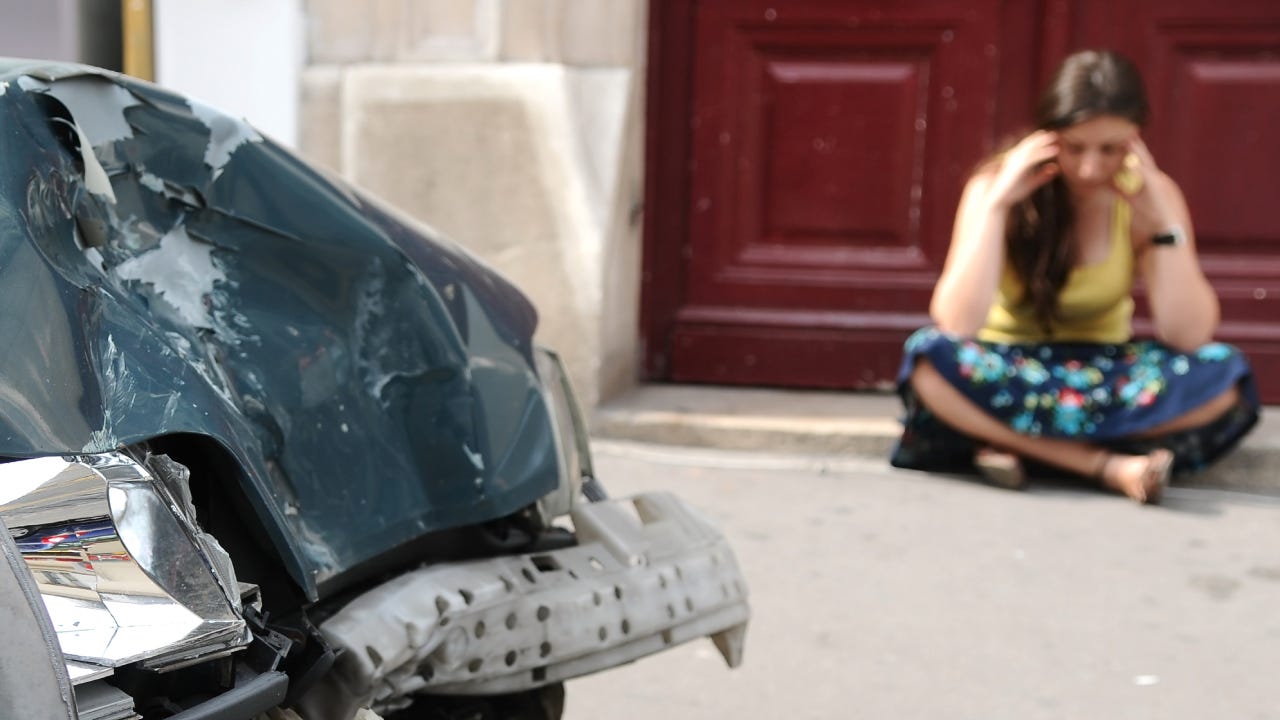Car insurance after a hit-and-run in Florida

Florida law requires all drivers to stop, exchange information and render aid at the site of a motor vehicle accident. However, not all drivers abide by this law. In 2023, Florida’s Department of Highway Safety and Motor Vehicles (FLHSMV) reported that nearly 25 percent of all motor vehicle crashes in the state were hit-and-run accidents. These accidents generate steep costs and can make auto insurance claims more complicated for both victims and perpetrators. Bankrate’s insurance editorial team reviewed Florida’s hit-and-run laws to explore the insurance implications of this type of accident.
Hit-and-runs in Florida
Florida state law strictly defines what constitutes a hit-and-run in the state. You could be charged with a hit-and-run under Florida law if you’re in an accident that results in injuries, death or property damage and:
- You leave the scene of an accident before exchanging information — including your name, address and vehicle registration number — with the other driver(s)
- You fail to render reasonable assistance, such as calling 911 or offering transport to a hospital, to anyone injured
Despite strict laws and steep penalties, hit-and-runs remain a serious problem in Florida. According to FLHSMV, Florida saw 104,273 hit-and-run crashes in 2023, a decrease of less than one percent since the previous year. The majority of these crashes only resulted in property damage, but some were fatal, with 271 deaths resulting from hit-and-runs in 2023. Of these fatalities, 76 percent were either cyclists or pedestrians.
Hit-and run laws in Florida
Florida law imposes strict penalties on drivers who violate the hit-and-run laws in accidents involving property damage, injuries or fatalities. The severity of penalties, as well as the nature of the charges, depends on the outcome of the accident:
- Property damage only: Second-degree misdemeanor charge with up to 60 days in prison and $500 fine
- Injuries: Second- or third-degree felony charge with up to five years in prison and $5,000 fine
- Fatality: First-degree felony charge with four to 30 years in prison and $10,000 fine
If you leave the scene of an accident involving either injuries or fatalities, you’ll also have your Florida driver’s license revoked for a minimum of three years. Hit-and-run charges in Florida with fatalities are subject to the Aaron Cohen Life Protection Act (Section 316.027 of the Florida Statutes), which mandates a minimum sentence of four years in prison for a hit-and-run accident involving the death of any person.
How does a hit-and-run affect car insurance in Florida?
If you’re convicted of a hit-and-run offense in Florida, you can expect a significant increase in your Florida car insurance rates. While exact data on the increase associated with a hit-and-run conviction is difficult to find, let’s use the average increase following an at-fault accident as a starting point.
According to Bankrate’s research, a Florida driver with a single at-fault accident on their record pays an average of $4,683 per year for full coverage insurance and $1,573 per year for state minimum coverage as of July 2024. That’s an average increase of between 36 and 50 percent for a single at-fault accident, regardless of outcome.
But a hit-and-run is more than an at-fault accident. It involves criminal charges, ranging from a second-degree misdemeanor to a first-degree felony. For this type of conviction, you’re likely looking at an insurance premium increase more in the range of 50 to 75 percent. That’s the average increase associated with a DUI, another moving violation that can be charged as a misdemeanor or felony in the state of Florida.
The only way to determine exactly how a hit-and-run might affect your insurance premiums is to compare quotes from multiple companies. If you’re looking for cheap auto insurance after a hit-and-run, working with an insurance agent could help you understand your situation and the options available to you.
What to do after a hit-and-run in Florida
If you are the victim of a hit-and-run accident in Florida, try to remain calm and take the following actions:
- Move your vehicle to a safe place: If your car is still driveable, move it out of the flow of traffic while staying as close to the scene of the accident as possible.
- Make sure that everyone is okay: Check on all passengers in your vehicle. If anyone has obvious or suspected injuries, call for medical assistance or arrange transport to a medical provider.
- Call the police: A police report will provide backup for any insurance claims that need to be filed, so it’s a good idea to call the police right away, and wait at the scene until they arrive. Try to alter as little as possible at the scene, and be ready to give them a statement about the accident.
- Document the scene: Take notes on anything you remember about the accident, including the time, date, location and weather conditions. Write down anything you remember about the other driver or vehicle, including the direction they were traveling as they left the scene or the make, color or body style of their vehicle.
- Check for evidence: A collision could leave evidence to potentially lead law enforcement to the at-fault driver’s vehicle. Look for broken glass or vehicle components on the ground or paint left on your vehicle. Don’t touch anything; instead, point it out to police when they arrive.
- Take photos: Photo evidence can help your insurance company process your claim more accurately and aid law enforcement investigations.
- Talk to eyewitnesses: If anyone observed the crash, ask them for their observations and request their contact information for follow-ups.
- Contact your insurance company: Reach out to your insurance company as soon as possible to report the accident and start a claim, if applicable.
Your coverage selections will determine what type of claim you can file with your insurance company following a hit-and-run accident. Be prepared to work with your insurer to make sure you get the payout you need.
Frequently asked questions
-
Depending on your coverage selections, your car insurance policy could cover some of your damages following a hit-and-run accident. By law, all Florida car insurance policies include personal injury protection, which you can use to file a claim for medical costs and other injury-related expenses for yourself or your passengers.
You may also be able to file a claim after a hit-and-run if your policy includes one of two types of optional coverage. If you have uninsured motorist coverage, you may also be able to use that insurance to help cover your medical bills. Finally, if you have collision coverage on your policy, you’ll be able to file a claim for any damage to your vehicle caused by the hit-and-run incident.
-
There are several ways to report a hit-and-run in Florida. You can dial *FHP (*347) on your phone to get in touch with the Florida Highway Patrol. You can also report a hit-and-run anonymously by calling the Florida Crime Stoppers at **TIPS (**8477). Additionally, Florida Crime Stoppers has a free mobile app for download on both Apple and Android devices.
-
Your car insurance may be impacted no matter which side of a hit-and-run you’re on. For the victim of a hit-and-run, their insurance premium may increase if they file a claim. For a driver who hits another vehicle and flees the scene, there will likely be a substantial increase in their insurance premiums if they are found. Further, the at-fault driver may need to maintain an SR-22 form for a number of years following the accident. The accident can also be added to the at-fault driver’s driving record. In some situations, the driver may have difficulty finding insurance companies that will offer them coverage at that point.
-
Every driver looks for something different in their insurance company. Some people want the lowest rates and the most discounts, while others are more concerned with customer service ratings. For this reason, the best car insurance company for one person may not be a good fit for the next. Before shopping for new insurance, you may find it helpful to list your priorities and use them as a guide. A discussion with a licensed insurance agent may also help.
-
Penalties for a hit-and-run conviction in Florida start with a $500 fine and up to 60 days in prison for a hit-and-run that results in property damage without injuries or fatalities. For hit-and-runs that involve injuries or fatalities, hit-and-run penalties in Florida range from $5,000 to $10,000 in fines and could include imprisonment for up to 30 years, with a minimum of four years for any conviction with fatalities. You’ll also be charged with a felony and lose your driving privileges for three years if you leave the scene of an accident with injuries or fatalities.
Methodology
Bankrate utilizes Quadrant Information Services to analyze July 2024 rates for all ZIP codes and carriers in all 50 states and Washington, D.C. Rates are weighted based on the population density in each geographic region. Quoted rates are based on a single, 40-year-old male and female driver with a clean driving record, good credit and the following full coverage limits:
- $100,000 bodily injury liability per person
- $300,000 bodily injury liability per accident
- $50,000 property damage liability per accident
- $100,000 uninsured motorist bodily injury per person
- $300,000 uninsured motorist bodily injury per accident
- $500 collision deductible
- $500 comprehensive deductible
To determine minimum coverage limits, Bankrate used minimum coverage that meets each state’s requirements. Our base profile drivers own a 2022 Toyota Camry, commute five days a week and drive 12,000 miles annually.
These are sample rates and should only be used for comparative purposes.
Incidents: Rates were calculated by evaluating our base profile with the following incidents applied: clean record (base), at-fault accident and single DUI conviction.
You may also like


How to avoid common pet insurance scams

West Virginia car insurance laws



